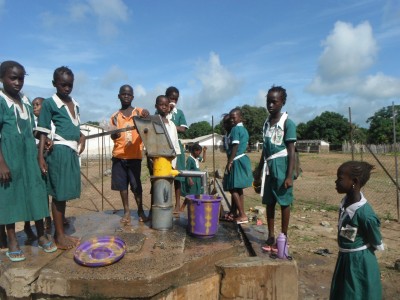 Gunjur is located in the West Coast region, Combo South District. The population depends mostly on farming and fishing for a living.
Gunjur is located in the West Coast region, Combo South District. The population depends mostly on farming and fishing for a living.
The Gunjur Lower Basic School was founded in 1950.
In the academic year 2011/12, 2,018 pupils were enrolled: 974 boys and 1,044 girls.
The pedagogic staff is composed of 65 teachers: 41 male and 24 female.
Mr Kebba Fatty, Head Teacher is the director. He is assisted by two deputy directors: Mr Landing Tamba and Mr Francis Da Sylva.
The subjects taught at school are: English, mathematics, science and social and environmental sciences (SES). SES is taught 5 hours per week and remains the main subject for familiarising the pupils with the EAF principles.

The director is giving all his support for the success of the FAO-NANSEN / Mundus marisactivities, consisting of promoting the integration of the principles of the Nansen ecosystem approach to fisheries (EAF) into the curriculum. In fact, he facilitated the organisation of the two field trips to Gunjur fish landing site.
In term of facilities and equipments, the school has no electricity, no computer. There is a library where certain books are available but without any furniture for the pupils to sit and read.
The lack of facilities means that the school has to travel to Brikama, a distance of about 20 km, if documents or work sheets need to be photocopied. Given the state of bush taxis in the area, this trip may take around 2 hours for a round trip.
Water is supplied from a well with a manual pump. This turned out to be more robust than the earlier solar pump, which became dysfunctional when the solar panel broke down. The school hopes that the panel will be repaired before the beginning of the next academic year.
 The director, upon taking up the assignment in September 2011, convened the school's management committee to deliberate about the poor state of repair of the fencing and main gate of the school, thus jeopardising security.
The director, upon taking up the assignment in September 2011, convened the school's management committee to deliberate about the poor state of repair of the fencing and main gate of the school, thus jeopardising security.
Some members are part of the parents association and particularly motivated to help with the repair and maintenance of the establishment through the payment of 15 dalasi per year and per pupil. Part of the walls is already re- build and the management committee hopes to finalize this project during the next academic year despite the resistance of poorer families to the payment.
As most of the pupils are living around three to four km away from the school, the World Food Programme (WFP) is providing support for lunch for all the pupils. This project is for two years and will end in 2012. So far, 2,018 dishes are served per day. The WFP provides rice, salt and oil. The rest (fish, meat and vegetables) is paid daily by the school from the funds collected from the parents.
 The next steps for improving teaching and learning conditions
The next steps for improving teaching and learning conditions
The director is very keen to follow-up these encouraging initiatives with upgrading basic school facilities, such as the access to a minimum of at least one PC to be powered by solar panel to improve teaching conditions of the EAF-Nansen principles and other subjects. The school also needs a digital camera to document their experiences in the field and in class.
A small investment fund is warranted to buy furniture for the library and to improve the stock of books, documents and other tools specific to environmental education. Mr. Fatty also argues for a special operational fund to pay for excursions and other extras for upgrading environmental education on a more regular basis or at least during the extended pilot phase until 2013 the schools participating in EAF teaching have agreed upon.
Those interested in networking and supporting the school's drive for improvements, can contact Esta dirección de correo electrónico está siendo protegida contra los robots de spam. Necesita tener JavaScript habilitado para poder verlo. until the school has its own e-mail account.








